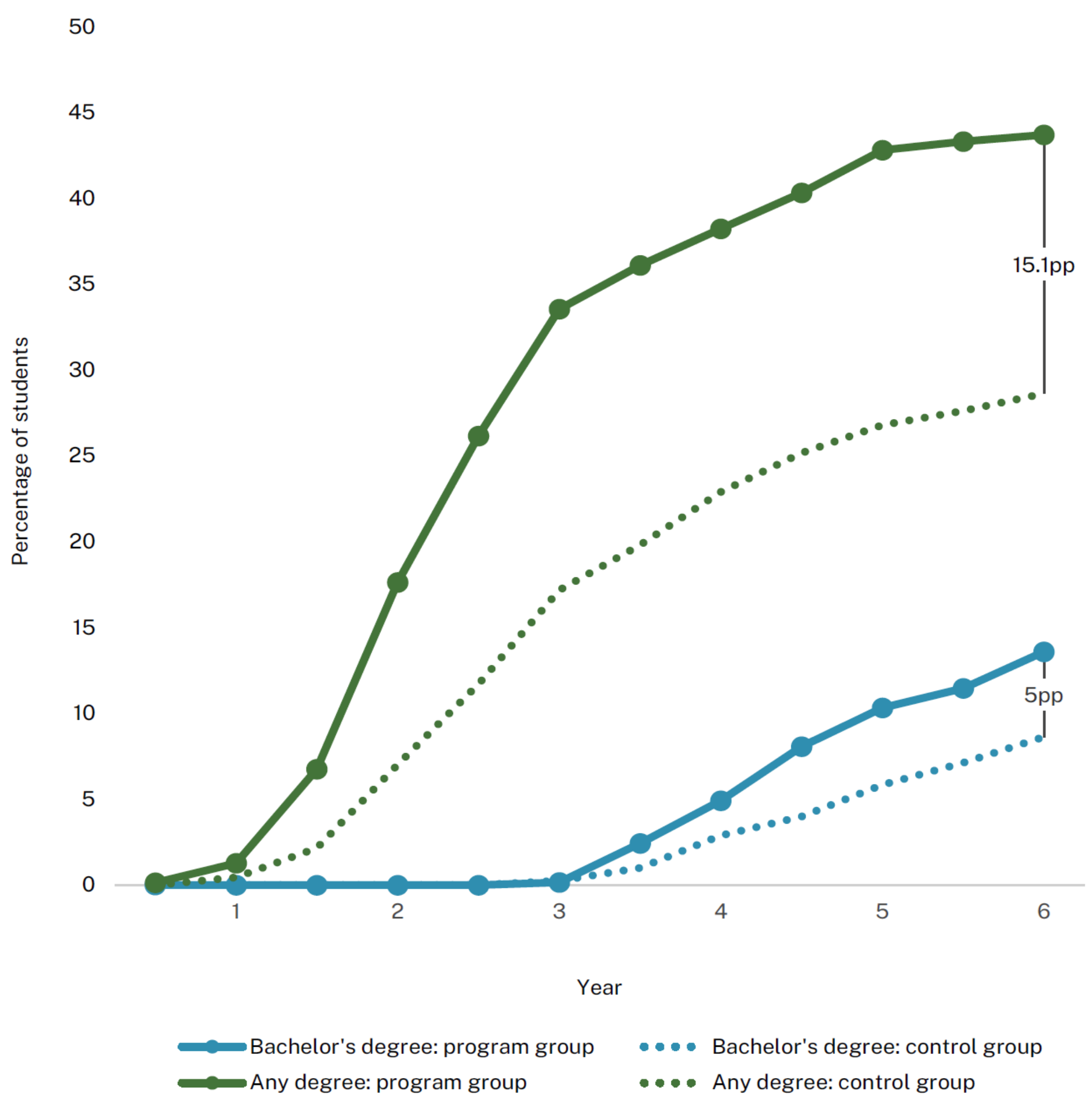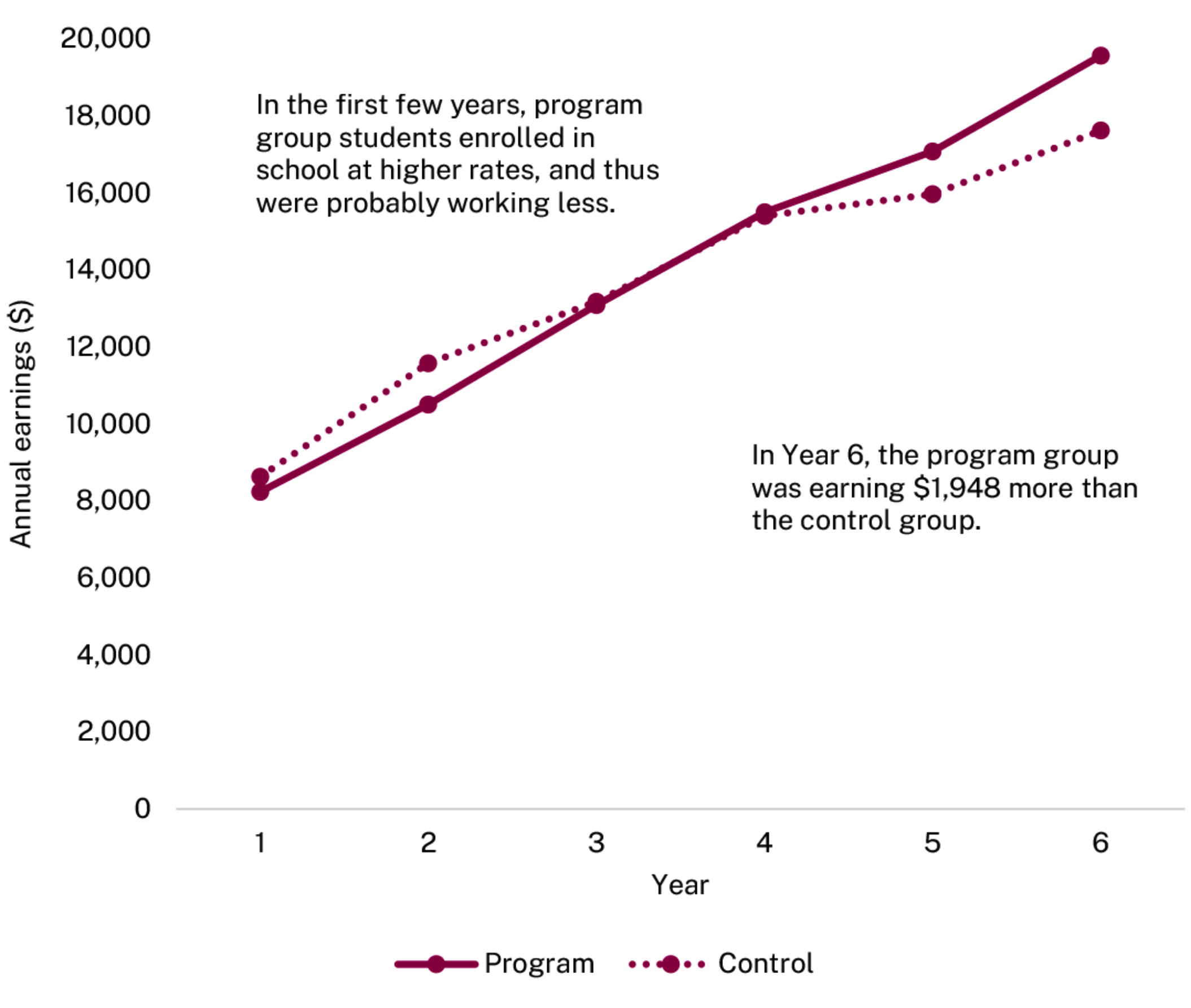Programs Also Substantially Increased Graduation Rates and the Attainment of Associate’s and Bachelor’s Degrees
Higher Graduation Rates, Higher Earnings
Positive Outcomes from the ASAP Ohio Demonstration

Graduation rates at community colleges are low, especially for students from low-income backgrounds. Back in 2015, three community colleges in Ohio implemented new, comprehensive student support programs with the goal of increasing graduation rates. These programs, designed to replicate the City University of New York’s (CUNY’s) proven Accelerated Study in Associate Programs (ASAP) model, offer students financial, academic, and personal support for up to three years. For further information regarding the program model and implementation, please refer to the report published in 2020 on effects after three years.
MDRC is evaluating the effectiveness of the Ohio programs using random assignment, a lottery-like process that placed students into either a program group, who had access to the programs’ services, or a control group, who did not. This design ensures that any differences in average outcomes (such as earnings) between the two groups reflect the direct effect of the program.
SUMMARY OF OHIO ASAP REPLICATION PROGRAM MODEL
ACADEMIC AND FINANCIAL SUPPORT FOR STUDENTS
- Enhanced advising
- Enhanced career development services
- Enhanced tutoring
- Tuition waiver
- Assistance covering textbook costs
- Monthly financial incentive
STUDENT REQUIREMENTS
- Enroll in classes full time; summer enrollment is encouraged
- Take developmental courses immediately
- Enroll in a consolidated schedule or blocked courses (or both)
- Enroll in a first-year seminar
MDRC’s evaluation of these programs found that after six years, the Ohio programs increased graduation rates by 15 percentage points and annual earnings by $1,948. Taken together, these findings are important because they (1) strengthen existing evidence that the ASAP model improves graduation rates and (2) provide new evidence that the ASAP model can increase long-term earnings.
This infographic summarizes the evaluation’s six-year findings, which are covered in more detail in a research brief published in April 2023.
Degree Findings
The ASAP model is well-known nationally for its dramatic effects on graduation rates, and the Ohio programs are no exception. After six years, 44 percent of program group students had earned a degree compared with 29 percent of the control group—a 53 percent increase and among the largest seen in a rigorous evaluation. The programs, furthermore, show effects even beyond community college: 14 percent of students in the program group earned a bachelor’s degree within six years compared with 9 percent in the control group (see Figure 1).
As the labor market increasingly demands workers with postsecondary credentials, improving graduation rates means improving students’ ability to secure family-sustaining wages.
Figure 1: Effects on Degree Receipt After Six Years, by Level

SOURCE: Colin Hill, Colleen Sommo, and Kayla Warner, “From Degrees to Dollars: Six-Year Findings from the ASAP Ohio Demonstration” (New York: MDRC, 2023).
Labor Market Findings
At Year 6, students in the program group were earning $1,948 more than the control group annual average of $17,626, an increase of 11 percent (see Figure 2). It is promising that only six years later—probably the earliest point at which one would expect to see effects on earnings—the Ohio programs were already producing substantial increases in earnings. It is important to note that while these earnings may seem low, 29 percent of the students in the sample had no earnings in Year 6 and therefore lowered the average with $0 in earnings. In addition, part-time workers are included in the sample, and the data exclude certain categories of employment, notably employment of student workers.
Figure 2: Impacts on Annual Earnings After Six Years

SOURCE: Hill, Sommo, and Warner (2023).
These novel labor market findings represent an important contribution to the growing body of evidence on comprehensive approaches to improve both educational and economic outcomes. These findings are also particularly noteworthy because replications of effective programs have often failed to achieve the original results, and because ASAP is not tailored to be a workforce-specific program.
Continuing Long-Term Follow-Up of the Evaluation
MDRC’s evaluation will continue to collect long-term academic and labor market data, and future briefs will discuss research findings after eight and ten years. Since this long-term evaluation is still in its early stages, it is unclear whether the effects observed at the six-year time point will continue. The upcoming briefs will dive deeper into the important questions of whether the effects of the programs will continue in the long term, as well as how the programs affect earnings.
Beyond the Ohio programs, as ASAP continues to be replicated across the country, further study of the long-term effects of these programs in a wider variety of contexts is crucial to broaden knowledge on effectively supporting students throughout college and preparing them for the workforce.
This infographic and long-term follow-up analysis of the ASAP Ohio Demonstration are made possible by support from Arnold Ventures and The Joyce Foundation.






